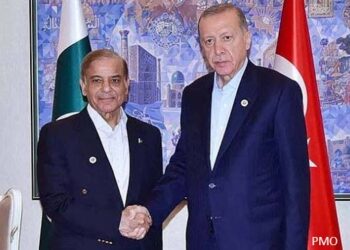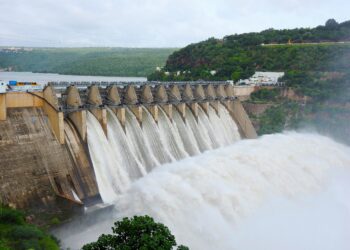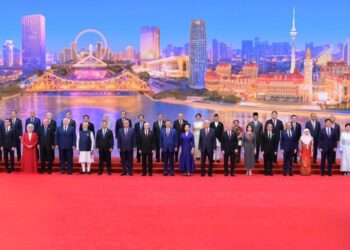By Kashif Hasan

South Asia is one of the most climate-vulnerable regions in the world, where population pressure, political disputes, and environmental upheavals form an inescapable knot. Pakistan and India, rivals since 1947, confront each other not only across militarised borders but also in the very air they breathe. Wars, military manoeuvres, reckless industrial growth, and climate change have forced both nations into a crisis whose heaviest burden falls upon the ordinary farmer, labourer, and the dispossessed.
Greenhouse Gases and Industrial Growth
Neither Pakistan nor India rank among the world’s top emitters, yet their vast populations and reliance on coal and unsustainable energy policies create suffocating urban smog. Delhi and Lahore breathe the same toxic air—an environmental truth no border can divide. Industrial growth without environmental safeguards is poisoning soil, water, and skies across both countries, ensuring that climate change is not an external threat but a domestic crisis.
War and the Environmental Toll
The wars of 1947, 1965, 1971, and the 1999 Kargil conflict devastated borderlands, forests, and villages, leaving landmines that still haunt farmers who seek only to till their soil. In Siachen, the world’s highest battlefield since 1984, military deployment has not only cost thousands of soldiers’ lives but has also accelerated the melting of the glacier. Fuels, waste, and military logistics have turned a vital water source into a ticking time bomb for the subcontinent’s water security. Beyond Siachen, every shell and bomb thickens the atmosphere, erodes glaciers, and pushes the planet’s temperature higher. Similarly, Afghanistan’s decades of war spilled into Pakistan, bringing refugees, terrorism, deforestation, and energy strain, with both India and Pakistan indirectly complicit in ecological scars that continue to spread.
Kashmir and Environmental Fragility
Kashmir is not just a territorial dispute—it is an environmental one. Its rivers form the lifeblood of both nations. Destruction in the valley or conflict along the Line of Control flows downstream into Punjab and Sindh, threatening millions of lives. Acts of terror, bomb blasts, and military operations destroy not only human lives but also the fragile ecosystems that sustain them.

Weather Manipulation and Technology
From HAARP theories to cloud-seeding experiments, weather modification has moved from conspiracy to reality. India has experimented with artificial rainfall, and Pakistan too has attempted such projects. Yet these technologies raise pressing ethical questions—are they deployed transparently for the public good, or used to serve elites, where rainfall in one city may condemn another to drought?
The Elite and the Poor
The elite plunder resources without accountability—air-conditioned mansions, fleets of cars, and sprawling lawns waste precious water and energy while escaping scrutiny for their carbon footprints. The poor, by contrast, live closest to nature’s rhythms. Farmers lose crops without compensation, labourers collapse in heatwaves without protection, and yet their modest lifestyles—bicycles, one-room homes, and frugal water use—are inherently more sustainable than the excesses of the wealthy.
Politicians, Media, and the Public
Political leaders in both countries treat climate change as a diplomatic ornament. Prime Ministers make lofty pledges at international forums but fail to invest in clean energy or enforce environmental regulations at home. Media outlets, driven by ratings, excel at trading accusations across borders but rarely initiate conversations on shared solutions. Ordinary citizens too remain divided. Some plant trees and avoid plastic, but indifference dominates. Water is wasted, forests are cut, and illegal construction replaces plantation. Suspicion lingers as people observe Western corporations selling plastics while preaching bans in the Global South. In a region where water is already weaponised, such waste borders on ecological vandalism.
The Way Forward
A path forward demands courage and cooperation. Indo-Pak climate dialogue must be institutionalised alongside peace talks, creating joint committees on environment. Siachen should be transformed into a Peace Park, with troops withdrawn to save the glacier. Environmental justice requires green taxes on elites and subsidies for the poor. Media must embrace responsibility over sensationalism, and public participation must be mobilised through national campaigns for plantation, water conservation, and waste reduction. Without these steps, environmental collapse will outpace political rivalries.
The Whisper of Time
The rivalry between India and Pakistan has spilled beyond bullets into rivers, skies, and glaciers. If climate change continues to be ignored, the next war will not be fought with tanks but with the absence of water, poisoned air, and barren soil. Poverty and apathy will be the most devastating weapons. Future generations will not remember us with gratitude but with curses if we fail to act. The choice before India and Pakistan is stark: build bridges of cooperation to confront climate change or perish together under its weight.























